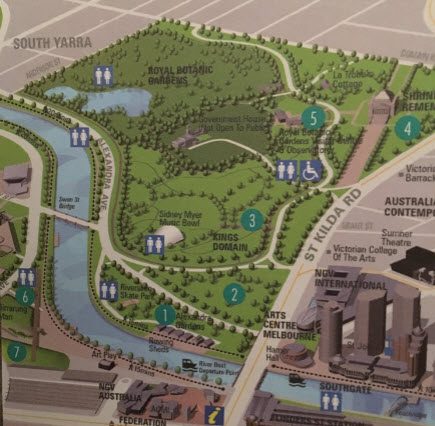Melbourne City Gardens Trail (Central Melbourne)

Melbourne's Yarra River Precinct is tailor-made for short, interesting walks on its three great themes: the arts, maritime heritage, and gardens. Each walk is about 90-120 minutes duration, although the wealth of attractions and points of interest along the way can easily fill-in many hours or an entire day.
Extensive planning and planting by the city's forefathers created a precinct distinguished by the greenery of significant parks and gardens - from the world-acclaimed Royal Botanic Gardens to the city's latest riverside public park, Birrarung Marr. In between, you'll find a wealth of smaller parks, gardens and reserves to create a beautiful and serene stroll.
For the Melbourne City Gardens Trail, start at the southern end of Princes Bridge, in the rowing precinct. The sight of a rowing scull emerging through an early morning mist and the sounds of rowing coaches cycling along the banks with megaphones in hand are quintessentially Melbourne.
Map with highlighted locations:

1 Alexandra Gardens is a charming retreat hidden behind the boathouses. It was created between 1896 and 1900 by river widening and straightening to alleviate flooding. The spoil was used to raise the height of the banks and to fill the lagoons. The ornamental design was the work of Carlo Catani, Chief Engineer of the Public Works Department. The five hectares of parkland feature mature trees set in spacious lawns and are filled with ornamental gardens, with distinctive Canary Island palms and shrub borders.
2 Queen Victoria Gardens is a five hectare oasis of emerald lawns, peppered with floral displays, ponds, and sculpture. It was established in the early 1900s as a memorial to Queen Victoria (marble statue 1907). Roses are a feature of the gardens. The Janet Lady Clarke Rotunda (1913) provides shelter and a place to sit and contemplate. The floral dock on St Kilda Road comprises 7,000 flowering and bedding plants, which are changed twice yearly. Swiss watchmakers donated this decorative timepiece to the city in 1966.
3 Kings Domain is an elegant 36 hectare patchwork of gardens and reserves. To celebrate Melbourne's centenary 17 hectares of the Government House grounds were transferred to public parkland in 1935. Hugh Linaker's design for the new park was carried out by sustenance workers to provide employment during the Great Depression. The shrubs and flower gardens between Government House Reserve and Kings Domain are in bloom most of the year. They contrast to the rest of the Domain, which is characterised by sweeping lawns, planted with both Australian and exotic trees in the 19th century. Within the reserve sits the Sidney Myer Music Bowl (1959), the Pioneer Womens' Memorial Garden (1934), Government House (1876), the Shrine of Remembrance (1934), and La Trobe's Cottage (1839). Memorials, statuary and commemorative trees punctuate the lawns.
4 Shrine of Remembrance Reserve. The symmetrical layout of paths radiating from the Shrine into the 13 hectares of landscaped reserve is balanced by trees arranged informally on the spacious lawns. The trees are a mixture of Australian and exotic species and most carry commemorative plaques representing the various sections of the Armed Services. The Garden of Appreciation marks the main entrance from Birdwood Avenue into the reserve and a picturesque Garden of Remembrance sits on the eastern slopes of the Shrine, commemorating post-WW2 conflicts. The imposing MacPherson Robertson Fountain in the south-west corner of the reserve was a gift to mark Melbourne's centenary in 1934.
5 The splendour of Melbourne's Royal Botanic Gardens began in 1846 when the site was chosen in response to petitions from early settlers. Victoria's first government botanist, Ferdinand von Mueller, laid out the gardens along scientific principles. William Guilfoyle, director 1873-1909, redesigned the gardens, relocating some 2000 of the original trees and creating the ornamental lake as the central feature. The landscape of sweeping lawns, gently curving paths and trees grouped to spectacular views is from the Guilfoyle period. Over 12,000 plant species from around the world are represented in the gardens, including specialist collections of exotic and Australian plants. Cafes and tea rooms, a gift and book shop, the National Herbarium, Ian Potter Foundation Children's Garden and Old Melbourne Observatory (1863) are part of Melbourne's botanic wonderland. The visitor centre is located on Birdwood Avenue. (Open daily. Guided tours available.)
Walk through the Botanic Gardens and cross Swan St Bridge.
6 The grassy expanse and raised rocks of Speakers Corner is a little known, colourful piece of Melbourne history. Well into the 1960s prime ministers, communists, evangelists, suffragettes and ordinary citizens gathered here to state their case to the gathered crowds. In the pre-television era it was a cost effective way to get your message across. The speakers and the hecklers provided some great entertainment.
7 Birrarung Marr is Melbourne's first major new parkland in more than 100 years. The eight hectare park was opened in NU and its wide open spaces and large sculptured terraces host festivals and events throughout the year. On the middle terrace, the 39 bell 'Federation Field of Bells' rings twice daily. Redgum Gully is planted with the type of trees that once lined the Yarra and the billabong beside the river symbolises the lagoons that once dotted the area. 'Birrarung' means 'river of mists' in the language of the Wurrundieri people and 'Marr' means the side of the river. The tops of the terraces provide expansive views of the city, Southbank, the Domain and Yarra River, while children love rolling down the grassy slopes.
This brochure "Melbourne City River Trails" is available at the Melbourne Visitor Centre at Federation Square.
Web Links
→ Melbourne City Arts Trail
→ Melbourne City Maritime Trail
→ Melbourne City Sports Trail









